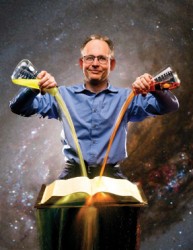
In his new blog “Cosmic Yarns,” Robert Scherrer, who is both chair of the Astronomy and Physics Department and a published science fiction author, explores the intersection between science and science fiction.

Science fiction authors often pick up some of the newest discoveries and innovations in the world of science and technology to spice up their stories. At the same time, they often just make things up to move the plot along.
So who better than a practicing physicist to help readers tell one from the other. That appears to be one of Scherrer’s motivations for writing the weekly blog. In his introductory post, Scherrer writes:
“Does the world really need another physics blog? Probably not. Or at least not from me. I want to try something a bit different here. I work as a cosmologist, mainly in the areas of dark matter and dark energy. But I also write science fiction sporadically, and I have always been intrigued by the interplay between science and science fiction — that’s what I want to explore in this blog. Of course, I will also reserve the right to pontificate on extraneous topics that I know nothing about.”
In his first post, Science Fiction and the Cosmic Speed Limit, Scherrer addressed the issue of the speed of light as the cosmic speed limit and then in following posts he examines the primary ways that science fiction authors have invented to get around this limit: faster-than-light warp drives, wormholes and generation ships. He points out that physicists’ attempts to create a warp drive and a stable wormhole both require something which may be equally as fabulous: negative energy, which may not exist.
On the other hand, the generation ship approach—invented by legendary science fiction writer Robert Heinlein—was not an attempt to violate the speed of light limit, but to evade it by building spaceships as self-contained worlds that take thousands of years to reach their goal while its crew is born, lives and dies in successive generations. According to the physicist, the issue this raises is not one of physics, but of human memory: Is it possible to preserve memories and knowledge for millennia. Scherrer reports that the best answer scientists have proposed is the “Stone-Age solution” of carving pictures into granite slabs.
What do you think our descendants a few thousand years from now will think when they read ‘The Far Side’ carved in stone?